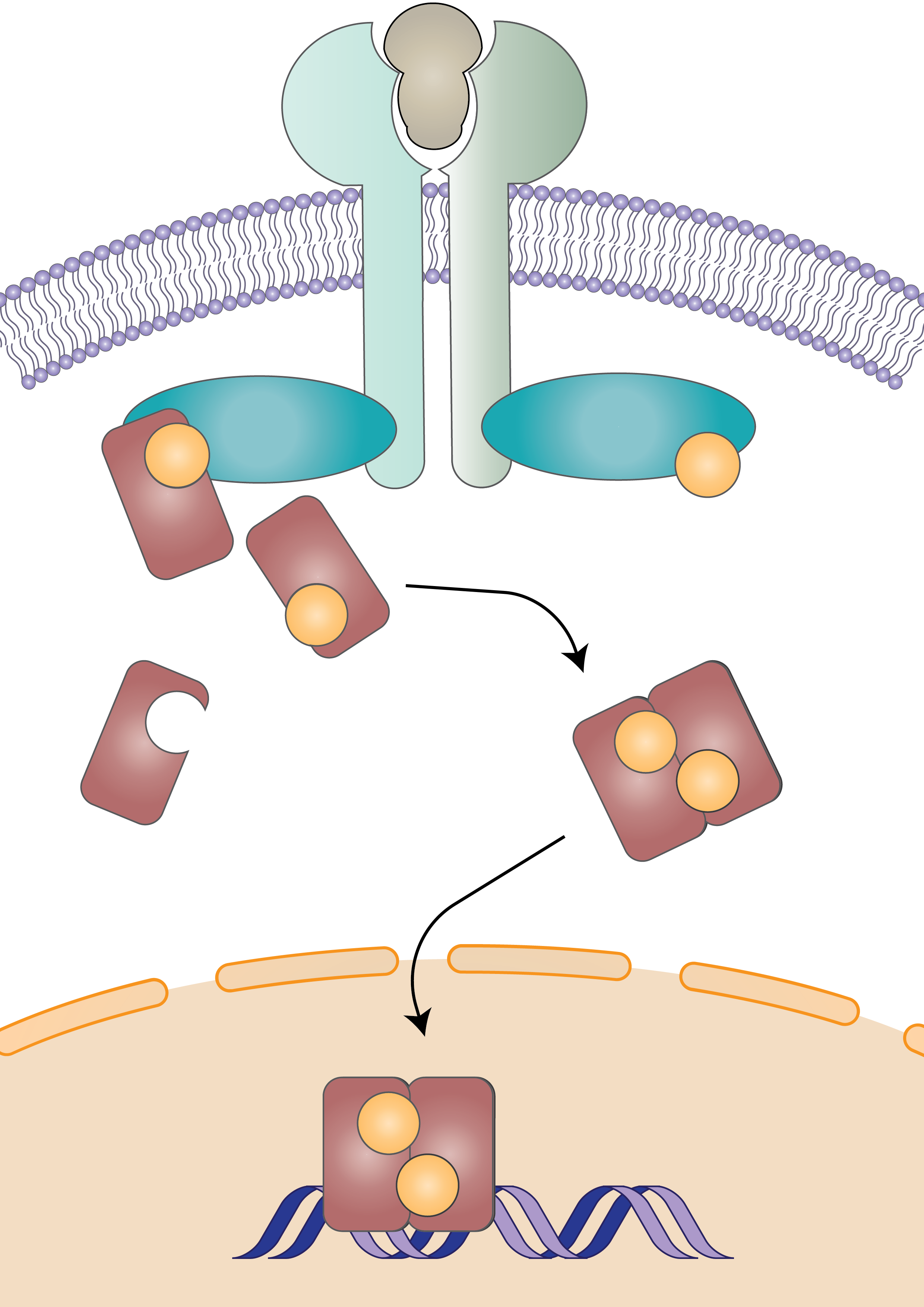Why STATs are so important?

The signal transducer and activator of transcription protein family consist of seven members: STAT1, STAT2, STAT3, STAT4, STAT5A, STAT5B and STAT6. Each protein is composed of 5 domains: : N-terminal, ‘coiled-coil’, DNA-binding, SH2 and C-terminal transactivation domain. Protein activity is dependent on phosphorylation of: tyrosine residue located in transactivation domain, which allows STAT protein to for dimers or more complexed structures and serine residue which enhances transcriptional activity of protein.
STAT proteins are involved in fundamental cellular processes such as cell growth, proliferation and apoptosis, mediation in IFN signalling, embryonic development, inflammatory and allergic immune responses. Deregulation of these proteins activation contributes to multiple disease phenotypes development.
Abnormal STAT signalling pathway activation is present in many human diseases. Lack of STAT1 block responsiveness to interferons, leading mice to suffer to bacterial and viral infections. It also causes malignant cells to undergo rapid growth and leads to increased tumor formation. Recent studies suggest a more complex role of STAT1 in carcinogenesis as well as in atherosclerosis. Experiments with mice lacking STAT2 showed defective antiviral responses to IFNα and IFNβ. What is more STAT2 activity may partly contribute to carcinogenesis. Constitutive activation of STAT3 is present in many cancers – breast, melanoma, prostate, head and neck squamous cell carcinoma (HNSCC), multiple myeloma, pancreatic, ovarian and brain tumors. STAT3 hyper activity is also observed in chronic inflammatory diseases, like rheumatoid arthritis and psoriasis. STAT4 activation is mainly linked with autoimmune diseases, e.g. Experimental Autoimmune Encephalomyelitis, an animal model of multiple sclerosis and systemic lupus erythematosus. Constitutive STAT5A and STAT5B activation is noticeable in chronic myelogenous leukaemia (CML), breast, uterine and prostate cancer and also HNSCC. In this respect, STAT5 and STAT3 share a similar function in promoting cancer and their activation has been described in 70% of solid and haematological tumors. Finally, STAT6 activation is recognized in lung and airway diseases (airway hyperactivity, mucus production), and also in regulation of allergic skin inflammation.
| STAT | Function |
|---|---|
| STAT1 |
|
| STAT2 |
|
| STAT3 |
|
| STAT4 |
|
| STAT5A |
|
| STAT5B |
|
| STAT6 |
|

Why STAT inhibition is worth checking?
Because of being crucial for multiple essential cellular processes STATs became highly investigated as potential drug targets. Because of their structure and mode of action- being dependent also on other protein families they are extensively examined for therapeutic purposes.
Searches for STAT3-targeting compounds, exploring the pTyr–SH2 interaction area of STAT3, are numerous and yielded many small molecules. In contrast, only a few inhibitors for other STATs are described.
Relevance of JAK-STAT pathway as therapeutic target is depicted by numerous ongoing studies involving multiple in silico, in vitro, ex vivo, in vivo methods which are followed by a number of clinical trials.
Why STAT inhibition is so tricky?
- Approach- direct or indirect. STATs activity may be inhibited directly by influencing eg dimerization (SH2 domain), DNA binding (DNA binding domain), direct inhibition of phosphorylation (transactivation domain). Indirect inhibitory effect is presented through inhibition proteins upstream STAT such as JAK2, TYK1 or multiple interferon or interleukin receptors.
- Targeted STAT domain. Depending on chosen target domain, inhibitors may display different features eg targeting SH2 domain often influence more than one type of STAT protein because of its high evolutionary conservation. However, influencing multiple STAT scan be promising therapeutic strategy for some disorders. For more specific inhibition DNA binding strategy seems to be better.
- Type of inhibitor. Similarly to “Targeted STAT domain” type of chosen inhibitor may significantly influence potency and specificity of inhibition. Currently there are investigated mostly: small compounds, antibodies, natural products (and their derivatives), ODN decoys, peptides and peptidomimetics.
Graphs
References
| URL | Description |
|---|---|
| https://www.nature.com/articles/nrd4088 | Therapeutic modulators of STAT signalling for human diseases |
| https://www.sciencedirect.com/science/article/pii/S009286740081288X | Targeted Disruption of the Stat1 Gene in Mice Reveals Unexpected Physiologic Specificity in the JAK–STAT Signaling Pathway |
| https://pubmed.ncbi.nlm.nih.gov/17328836/ | Transcription Protein STAT1: Biology and Relation to Cancer |
| https://www.ahajournals.org/doi/full/10.1161/CIRCULATIONAHA.107.696922?url_ver=Z39.88-2003&rfr_id=ori:rid:crossref.org&rfr_dat=cr_pub%20%200pubmed | Signal Transducer and Activator of Transcription 1 Is Required for Optimal Foam Cell Formation and Atherosclerotic Lesion Development |
| https://cancerpreventionresearch.aacrjournals.org/content/3/4/495 | STAT2 Contributes to Promotion of Colorectal and Skin Carcinogenesis |
| https://www.nature.com/articles/1203527 | STATs in oncogenesis |
| https://www.nature.com/articles/nm0605-595 | Validating Stat3 in cancer therapy |
| https://pubs.acs.org/doi/10.1021/jm300207s | Small Molecule Inhibitors of Signal Transducer and Activator of Transcription 3 (Stat3) Protein |
| https://www.sciencedirect.com/science/article/pii/S0925443910001018 | Th1 versus Th17: Are T cell cytokines relevant in multiple sclerosis? |
| https://www.sciencedirect.com/science/article/pii/S0085253815548217 | Targeting transcription factor Stat4 uncovers a role for interleukin-18 in the pathogenesis of severe lupus nephritis in mice |
| https://onlinelibrary.wiley.com/doi/full/10.1002/ijc.11619 | Stat5a is tyrosine phosphorylated and nuclear localized in a high proportion of human breast cancers |
| https://ashpublications.org/blood/article/117/12/3421/20411/The-STAT5-inhibitor-pimozide-decreases-survival-of | The STAT5 inhibitor pimozide decreases survival of chronic myelogenous leukemia cells resistant to kinase inhibitors |
| https://www.nature.com/articles/nrc1275 | The STATs of cancer — new molecular targets come of age |
| https://www.atsjournals.org/doi/full/10.1165/rcmb.2008-0163OC?url_ver=Z39.88-2003&rfr_id=ori:rid:crossref.org&rfr_dat=cr_pub%20%200pubmed | A Novel STAT6 Inhibitor AS1517499 Ameliorates Antigen-Induced Bronchial Hypercontractility in Mice |
